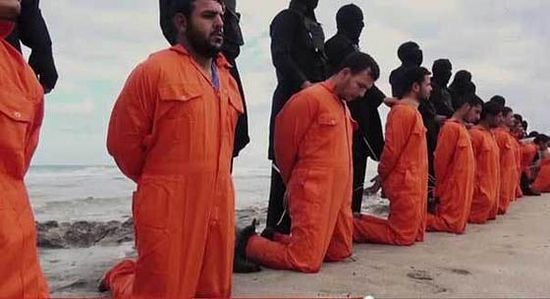Pope Francis has recognised as martyrs a group of 21 Coptic Orthodox Christians murdered by Islamic State terrorists eight years ago.
The Holy Father told Coptic Pope Tawadros II, the Patriarch of the See of St Mark, that the martyrs would be inserted into the Roman Martyrology “as a sign of the spiritual communion that unites our two Churches”.
The Coptic martyrs included 20 Egyptians and a man from Ghana who were beheaded by jihadis in Sirte, Libya, who filmed them in prayer as they died on February 15, 2015.
During their audience in Rome, Pope Tawadros gave Pope Francis a reliquary of the Coptic martyrs.
Pope Francis said: “These martyrs were baptised not only with water and the Spirit, but also in blood, in a blood that is the seed of unity for all followers of Christ”.
The Coptic patriarch was in Rome to commemorate the 50th anniversary of the Joint Christological Declaration, a milestone in relations between the Coptic Orthodox and Catholic Churches.
During a press conference Pope Tawadros II told reporters that the martyrs’ bodies were exhumed in 2018 and brought to Egypt.
The Coptic Church then built a shrine in their honour in El-Aour, the hometown village of most of the men.
“We ask for their prayers often,” said Pope Tawadros, “and we believe they continue to offer us a great blessing.”
He urged Catholics to invoke their intercession as well.
The Coptic Pope also laid out four steps to follow along the path toward reconciliation and Christian unity, pointing to the figures depicted on a cross he has displayed while in Rome.
Pope Tawadros said the first step is that of fraternity in Christ, expressed through joint activities.
The second step, he added, includes mutual understanding through the study of traditions, sacraments and “everything that has to do with the Churches”.
The third step, he said, involves liturgical and informal dialogue, including dialogue among young people and members of the Churches’ respective clergy. The fourth step is prayer, “because prayer can work miracles”.
“Once we have completed these four steps,” said the Coptic Pope, “we arrive at the heart of Christ, and this takes a long time. But we believe that the Holy Spirit is with us on this journey.”
Other non-Catholic Christians have been previously inserted into the Roman Martyrology.
They include the 11<sup>th</sup> century Orthodox Slavic Ss Theodosius and Anthony of Pečerska, and the 14<sup>th</sup> century Ss Stephen of Perm and Sergius of Radonezh.
Pope Francis has recognised as martyrs a group of 21 Coptic Orthodox Christians murdered by Islamic State terrorists eight years ago.
The Holy Father told Coptic Pope Tawadros II, the Patriarch of the See of St Mark, that the martyrs would be inserted into the Roman Martyrology “as a sign of the spiritual communion that unites our two Churches”.
The Coptic martyrs included 20 Egyptians and a man from Ghana who were beheaded by jihadis in Sirte, Libya, who filmed them in prayer as they died on February 15, 2015.
During their audience in Rome, Pope Tawadros gave Pope Francis a reliquary of the Coptic martyrs.
Pope Francis said: “These martyrs were baptised not only with water and the Spirit, but also in blood, in a blood that is the seed of unity for all followers of Christ”.
The Coptic patriarch was in Rome to commemorate the 50th anniversary of the Joint Christological Declaration, a milestone in relations between the Coptic Orthodox and Catholic Churches.
During a press conference Pope Tawadros II told reporters that the martyrs’ bodies were exhumed in 2018 and brought to Egypt.
The Coptic Church then built a shrine in their honour in El-Aour, the hometown village of most of the men.
“We ask for their prayers often,” said Pope Tawadros, “and we believe they continue to offer us a great blessing.”
He urged Catholics to invoke their intercession as well.
The Coptic Pope also laid out four steps to follow along the path toward reconciliation and Christian unity, pointing to the figures depicted on a cross he has displayed while in Rome.
Pope Tawadros said the first step is that of fraternity in Christ, expressed through joint activities.
The second step, he added, includes mutual understanding through the study of traditions, sacraments and “everything that has to do with the Churches”.
The third step, he said, involves liturgical and informal dialogue, including dialogue among young people and members of the Churches’ respective clergy. The fourth step is prayer, “because prayer can work miracles”.
“Once we have completed these four steps,” said the Coptic Pope, “we arrive at the heart of Christ, and this takes a long time. But we believe that the Holy Spirit is with us on this journey.”
Other non-Catholic Christians have been previously inserted into the Roman Martyrology.
They include the 11<sup>th</sup> century Orthodox Slavic Ss Theodosius and Anthony of Pečerska, and the 14<sup>th</sup> century Ss Stephen of Perm and Sergius of Radonezh.



